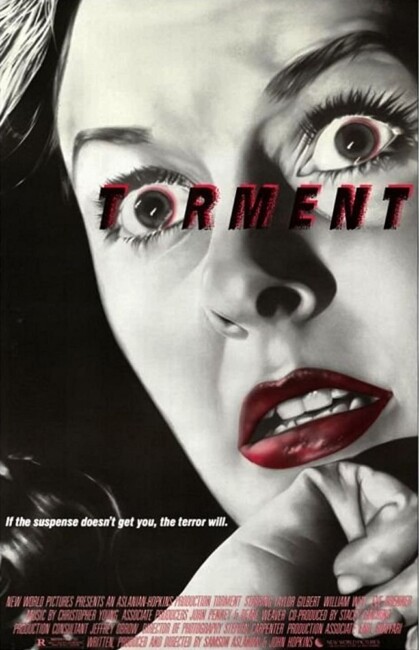Crew
Directors/Screenplay/Producers – Samson Aslanian & John Hopkins, Photography – Stephen Carpenter, Music – Chris Young, Makeup – Matthew Mungle, Art Direction – Chris Hopkins. Production Company – Aslanian-Hopkins Productions.
Cast
William Witt (Killer), Taylor Gilbert (Jennifer), Eve Brenner (Mrs Courtland), Warren Lincoln (Michael Courtland), Doug Leach (Officer Tillman), Najean Cherry (Helen)
Plot
A middle-aged man calls a radio talkback line from his hotel room, describing how he took a woman to a bar, only for another man to come and pick her up while he was away getting drinks. In anger, he followed the two of them to the man’s apartment and shot them both. Investigating detective Michael Courtland swears on tv that he will find the killer. After visiting the crime scene with Michael, his fiancee Jennifer thinks that someone is following her. Her fears are dismissed by the police because she has cried wolf before. However, the killer proceeds to follow her home where he terrorises Courtland’s wheelchair-ridden mother and pursues Jennifer through the house.
Torment is a film that received almost no attention when it first came out, not even any genre press, and was not widely distributed or seen. Within the limits of a low-budget film, it is a reasonable entry and something that is at least worthy of rediscovery.
Directors Samson Aslanian and John Hopkins do rather well. The shocks are always made unconventional by the twists of perverse psychology on show – particularly the opening attack where William Witt offers the man who took his girl the gun, mockingly challenging him to protect her by killing him. The gallery chase scene is nicely mounted, albeit reminiscent of the similar one in Dressed to Kill (1980), with some good perspective architectural effects.
Other set-ups and shots impress – a side-tracking shot following Taylor Gilbert through the cellar, abruptly revealing William Witt’s face reflected on a small hand-mirror facing the camera amid the junk. When the attacks mount, Aslanian and Hopkins generate some reasonably intense material – William Witt grabbing Eve Brenner through a window trying to twist her hands to slash them on the broken glass, shooting blanks at her, and she fighting back with kitchen knife and gun.
This is a fine lead up to the sustained climax – with the brutal stabbing of the maid as she is pinned against a wall trying to reach an intercom button; the fighting around the darkened house with William Witt ranting religious mania as he forces Taylor Gilbert to her knees with a gun to her head, later eerily insisting that it is not he the police are going to put away and that her father is really dead; his coming up behind and killing the cop who is trying to make out the warnings of Taylor Gilbert and Eve Brenner from an upstairs room; and the scariest rendition of On the Good Ship Lollipop you will ever hear through the house via intercom.
It is a lack of outlook that stops Torment from ever looking forward to the successes of a contemporary like Halloween (1978) or The Hitcher (1986). The screenplay is not up to much, although the revelation of William Witt as Taylor Gilbert’s father is an effective twist. However, Witt is poor casting – his bland, sallow dullness making for a psycho that seems to be more like a suitcase has been placed before the camera to spout dialogue by remote-control.
Samson Aslanian and John Hopkins never went on to make another film, while the cast have never been heard from again, however a number of those on the credits have. The cinematographer was Steven Carpenter who has a minor career as a genre director with the likes of The Dorm That Dripped Blood/Pranks (1982), The Power (1984), The Kindred (1986) and Soul Survivors (2001). It was also one of the earliest film credits of Christopher Young who has since become a regular film musician and of Matthew Mungle who has gone onto numerous credits as a makeup effects artist.
Trailer here


